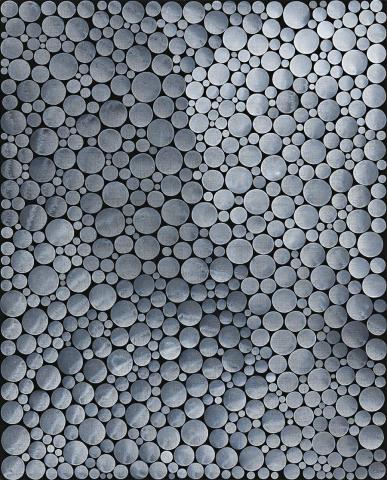INFINITY DOTS (HRT), 2001
YAYOI KUSAMA
synthetic polymer paint on canvas
162.0 x 130.0 cm
signed, dated and inscribed verso: Yayoi Kusama / 2001 / [Japanese script] DOTS / (HRT)
Ota Fine Arts, Tokyo (label attached verso)
Roslyn Oxley9 Gallery, Sydney (label attached verso)
Private collection, Sydney
Yayoi Kusama, Roslyn Oxley9 Gallery, Sydney, 11 April – 4 May 2002
'... a polka-dot has the form of the sun, which is a symbol of the energy of the whole world and our living life, and also the form of the moon, which is calm. Round, soft, senseless and unknowing. Polka-dots become movement ... Polka-dots are a way to infinity.'1
One of the most exciting, original and prolific artists of our time, Yayoi Kusama has remained at the forefront of developments in contemporary art practice for over half a century. Widely respected for an endlessly vibrant and stylistically varied oeuvre encompassing painting, sculpture, poetry, fiction, performance, film-making, fashion, installation and 'happenings', her influence may be discerned in tendencies as diverse as Pop Art, Surrealism, Minimalism, the Zero and Nul movements, Eccentric Abstraction and Feminist art. Notably however, Kusama herself consistently eludes any singular classification, occupying a highly unique role as the eternal 'insider-outsider'. Whether as an Asian woman in the male-dominated New York art scene of the 1960s, or as a liberated, worldly artist in conservative Japan, she transcends gender, generation, geography and even the very notion of art itself in her infinite consciousness and enduring mission to reveal through her mysterious and highly idiosyncratic forms the 'invisible interconnectedness' of everything within the universe.
Propelled by a seemingly insatiable desire to not only develop a Western style of painting but position herself within the international avant-garde, in 1958 Kusama made the radical move from her small, feudalistic hometown in the Japanese hinterland to bustling New York. Ever the frenetic experimenter, she quickly absorbed everything this dynamic city had to offer, cultivating friendships with influential figures such as Donald Judd, Frank Stella and Joseph Cornell, and unashamedly exploiting her exotic 'Oriental' allure to gain attention in a manner reminiscent of fellow consummate self-publicist, Andy Warhol. Remarkably, within barely a year she had revolutionised the local art scene with her signature motifs of the infinity net and its negative space, the polka dot- 'two interchangeable idioms that she adopted as her alter ego, her logo, her franchise and weapon of incursion into the world at large.'2 Stemming from hallucinations that had plagued the artist since childhood, whereby objects surrounding her became unified in a single pattern, by the late 1960s the polka-dot in particular had become inextricably linked to the artist's strategy of self-obliteration. A prominent feature of her 'happenings' and performances of the period (usually daubed on the naked bodies of participants), the motif symbolically neutralised the ego which Kusama blamed for the horror and destruction of the Vietnam War; as she exhorted her audience, 'Obliterate your personality with polkadots. Become one with eternity. Become one with your environment... Self-destruction is the only way to peace.'3
Over the six decades that followed, her resolutely disciplined and singleminded practice would, similarly, continue to repeat and obliterate itself - with the polka-dot remaining the central, unifying theme (indeed, Kusama herself became affectionately known as 'the Polka Dot Princess'). Created around the turn of the century when Kusama was producing her highly acclaimed large, room-sized environments such as I'm Here, but Nothing, 2000, and series of balloon installations entitled Dots Obsession, 1996, the present painting Infinity Dots (HRT), 2001 is a compelling example of the iconic, mesmerising images for which the artist is so renowned. With its transcendent beauty, monochromatic palette and contemplation of the infinite through endless, compulsive dot patterning, it encapsulates well the artist's obsessional vision, stunning originality and lifelong preoccupation with the various visual processes of her own self-obliteration.
1. Kusama quoted in Hoptman, L., et al., Love Forever: Yayoi Kusama 1958-1968, Los Angeles County Museum of Art, Los Angeles, 1998, p. 124
2. Hoptman, L., 'Yayoi Kusama: A reckoning', in Hoptman, L., Yayoi Kusama, Phaidon Press, London, 2000, p. 344
3. Kusama quoted at <http://interactive.qag.qld.gov.au/looknowseeforever/works/dots/
VERONICA ANGELATOS
